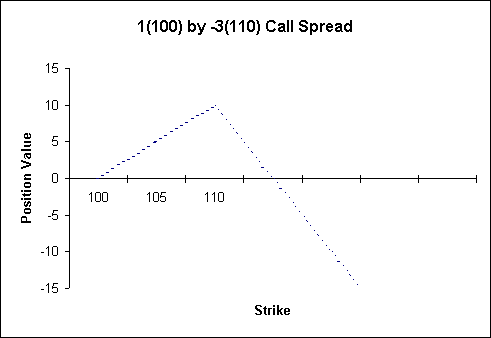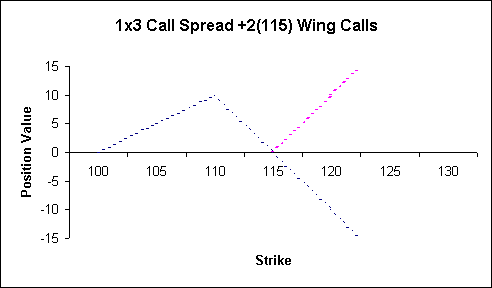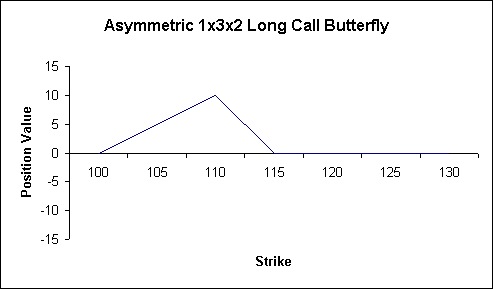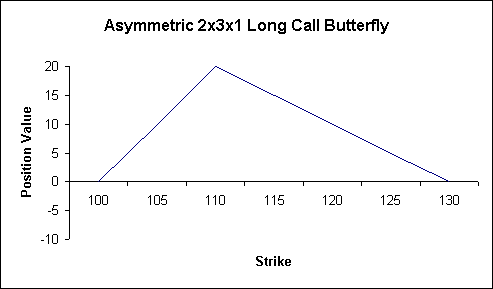| |
How do
we close the Butterfly? Page 2
We have spent a lot of
time on what is a relatively trivial matter, developing
the graphic intuition for what comes next. (Any good
option trader has some kind of graphic vision with regard
to the response of his position along several axes to
market forces, and any memorable formula should have a
graphic intuition behind it. An old professor of mine,
way back in doctoral school days, once said something to
the effect that you should be able to read any formula
from the inside out, building your graphic vision of it.
If you cannot, the formula is probably of no human value,
and you should hum it instead. But we digress...)
digression
-
- Now, let's expand the
ratio spread of the prior example into a 1x3, and
see how the picture changes. This will set up the
graphic intuition a bit further. Our position now
is:
Long one 100 call,
Short three
110 calls
Where is the closing call
wing strike here? Let's look at the pictures: The
profit/loss payoff of this position is less well known,
but still trivial. Again ignoring premia at expiration,
we have:

Again, the directional
risk in this position begins at strike X and increases
without bound with the underlying. This time you will
note that the slope of the downward line is twice that of
the upward line. This is because we are net two calls
short, (= long one call, short 3 calls) whereas in the
previous example we were one call short. This implies
that to neutralise the ratio spread by creating an
odd-shaped butterfly, we will need to purchase two
closing calls.
-
-
-
-
-
-
-
-
-
-
-
-
-
-
-
- In the previous
symmetric butterfly example, the distance from
the inside strike to the closing, outside strike
as 20, and the distance from the short (soon to
become middle) strike to the outside strike was
10, which was equal to the distance from the
inside strike to the middle strike (the minus
sign is the "distance" operator so this
was equal to 110-100). What is the closing strike
going to be here? In this example, you might guess (or
pick off the graph) that the closing strike will
be set at 115, and that we need two options to
negate the directional risk of the position from
that point onwards:
-

Note that the same graphic
neutralisation analysis applies to this 1x3 as applied to
the 1x2 in the prior example.
-
-
-
-
-
-
-
-
-
-
-
-
- The two positions sum
to zero, this time above 115, leaving us with a
less well known, but still traded, assymetric
butterfly: tidbit
Long 1x 100
Call
Short 3x 110
Call
Long 2x 115
Call

Here, again
ignoring premia, we have a crack at making money
anywhere between 100 and 115 and no losses that
arise anywhere else.
Now, examining
this poor misshapen critter, we can derive the
following intuition about how many options we
need to close the butterfly, and where they
should be: To turn unlimited directional risk
into bounded directional risk with a naked
spread, we will always need to buy back the
number of options that we are net short. In this
case we were Short 3, Long 1 option, in other
words, Net Short two options.
The furthest
distance that the closing strike can be must be a
function of the distance between the opening and
middle strikes of the spread, stretched or
scrunched by number of options Net Short. (The
stretch or scrunch operator is the division
sign).
In the case at
hand, the distance between the middle strike of
the fly and the closing strike of the fly (110 -
115) is equal to the distance between the opening
and middle strikes (100 - 110), scrunched by the
slope of the unbounded risk we want to neutralise
(-2) which is equal to the number of calls we are
net short (+1 -3). Neutralising a position will
mean taking its mirror image geometrically, which
is equivalent to multiplying by -1.
Expressed
arithmetically, to close the 1(100) x -3(110)
call spread, we need
-1*(+1-3)=2
Calls, struck at (proceeding from left to
right)
3(100 -
110) / (1-3) = -30 / -2 = +15 points away
from the opening strike.
So we buy 2 calls
struck at 115 to complete this butterfly.
Now, this works
where the ratio spread is less than 2:1 as well:
Assuming the
following position:
Long
two 100 Calls
Short
three 110 Calls
The remaining wing
of the asymmetric butterfly would be +1 Call
struck at 130:

-
- So much for
the intermediate geometric insight. We'll
develop these points as well, but for the
moment we should emphasise and extend the
practical result:
We can
view any ratio spread as merely an incomplete,
perhaps asymmetric, butterfly.
|
![]() A Couple of
Calculations Nobody Ever Makes
A Couple of
Calculations Nobody Ever Makes